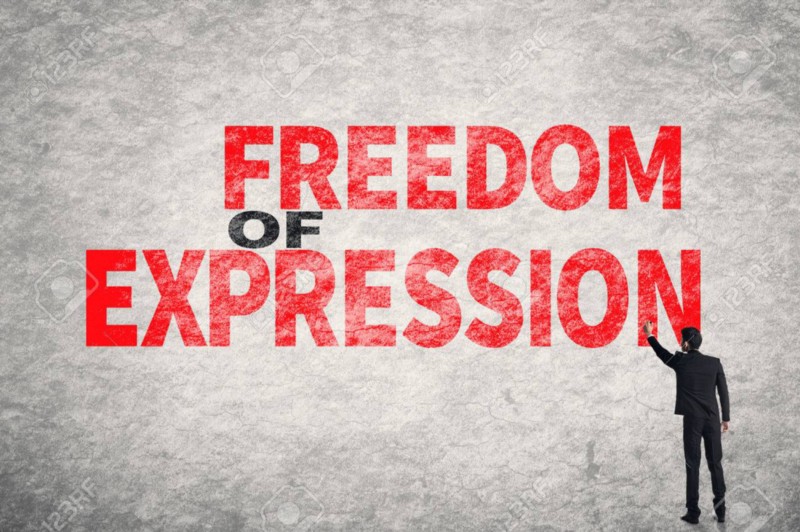BTC y la censura. por Craig Wright.
Texto original: de Craig Wright
15 de abril de 2019
Hay quienes intentan explicar cómo Bitcoin actúa sobre la resistencia a la censura. Principalmente, las mismas personas se asocian con la estafa fraudulenta BTC, es decir, la bifurcación alterada por un airdrop del código de Bitcoin diseñado para confundir al inversionista ignorante.
Vamos a explorar el tema de la mentira que se propaga con BTC.
Una de las mejores características de una cadena de bloques descentralizada es la resistencia a la censura. Con el dinero en su cuenta bancaria, un tercero tiene control sobre dónde y cuándo puede enviarlo. Con Bitcoin, puede enviar dinero a cualquier dirección que desee sin temor a la interferencia del gobierno. Sin embargo, la libertad no es el orden natural del mundo. La lucha contra la opresión y la censura es una batalla constante. Si bien Bitcoin tiene una historia importante de eludir la censura, analizaremos las amenazas omnipresentes contra la criptomoneda y su nivel de resistencia.
La afirmación es clara: los de Bitcoin Core buscan decir cómo evitan la censura y permiten cualquier cosa. Es absolutamente falso.
BTC se erosionó la primera vez que se permitió un bifurcación suave “soft fork”. No hay bifurcaciones en Bitcoin. La seguridad de Bitcoin se basa en un protocolo estable.
-
Transparente.
-
Inmutable
-
Resistente a la censura.
Bitcoin es un sistema basado en un protocolo estable. Es seguro siempre que el protocolo sea correcto y no cambie. Contra tal protocolo, por supuesto, va el ataque que han usado aquellos que buscan alterar Bitcoin. Pero en realidad, no han atacado a Bitcoin; más bien, han engañado a personas que no están familiarizadas con Bitcoin para que crean que una copia “airdrop” de otro sistema es Bitcoin. Y la copia de lanzamiento es lo que resultó en BTC (Core).
Como expliqué cuando escribí el White Paper:
Si un atacante codicioso es capaz de reunir más poder de CPU que todos los nodos honestos, tendría que elegir entre usarlo para defraudar a las personas mediante el robo de sus pagos, o usarlo para generar nuevas monedas. Debería encontrar que es más rentable jugar según las reglas, reglas que lo favorecen con más monedas nuevas que todos los demás combinados, que socavar el sistema y la validez de su propia riqueza.
Es importante destacar que, cuando consideramos a un atacante con más poder de hash en Bitcoin, incluso si el atacante logra reunir más del 50% de la red (mediante el poder de hash minado) bajo su control, no abre el sistema a cambios arbitrarios. como crear valor de la nada o sacar dinero que nunca perteneció al atacante. Los nodos no aceptarán una transacción no válida como pago, y los nodos honestos nunca aceptarán un bloque que los contenga. Un atacante solo puede intentar cambiar una de sus propias transacciones para recuperar el dinero que gastó recientemente.
Ningún nodo en la red Bitcoin, ningún minero ni comerciante, y ciertamente ningún sistema SPV aceptará un cambio arbitrario. El protocolo está escrito en piedra.
La única forma en que Bitcoin puede expresar resistencia a la censura es tener un protocolo estable. Con un protocolo estable, lo que se puede censurar temporalmente hoy, por cualquier razón, siempre se puede reproducir más tarde.
Un protocolo estable es importante; una transacción firmada sigue siendo válida en Bitcoin. Tal no es el caso cuando el protocolo cambia. La introducción de cambios en el protocolo significa que una transacción que actualmente es válida puede no ser válida más adelante. Una transacción firmada con una fecha futura utilizando nLockTime en Bitcoin seguirá siendo válida no solo ahora, sino dentro de una década o dentro de 100 años. Tan pronto como se haya alcanzado el tiempo especificado en el bloqueo de tiempo, la cadena de bloques aceptará la transacción. En la peor adición e incumplimiento del protocolo de Bitcoin, P2SH, una alteración tan insegura permitió que los mineros fueran eliminados de la ecuación. El contenido de una transacción que usa P2SH ahora no se puede verificar ni validar. En consecuencia, las transacciones que no son válidas pueden incorporarse fácilmente en la cadena de bloques. Más importante aún, las transacciones que son válidas pueden hacerse inválidas.
Los cambios en el protocolo dejan las transacciones que ya están en la cadena de bloques para ser aisladas de una manera que no se pueden gastar más tarde. Por ejemplo, si una transacción se incorpora a la cadena de bloques utilizando un código de operación que actualmente es válido pero que luego se considera que no es válido, los mineros no pueden analizar la transacción hasta que se envíe el recibo de pago, que puede ocurrir en un momento posterior a un Soft Fork ya ha invalidado el contenido de la transacción.
Para que una transacción sea resistente a la censura, debe poder reproducirse ahora y en el futuro.
Si cambia el protocolo, no puede hacer la misma promesa. Así que BTC está lleno de censura. En consecuencia, BTC no es Bitcoin, y se trata de censura. Cada vez que cambias el protocolo, censuras una transacción. Ya no hay forma de saber qué transacciones pueden o no ser válidas debido a la adición de pago al hash de script (P2SH), y peor aún, en la copia doble de Bitcoin, BTC, SegWit significa que no puede determinar el formato de firmas o códigos de operación que pueden estar allí en el futuro.
Bitcoin no cambia el protocolo. Es por eso que corregiremos los errores en el código incorrecto que se ha introducido en Bitcoin y luego nos aseguraremos de que el protocolo esté bloqueado y establecido en piedra como se diseñó.
Si puede cambiar el protocolo, CENSURA una parte de la población de transacciones. Por lo tanto, BTC no es resistente a la censura ni Bitcoin.
——————————————————–

Craig Wright (Bitcoin SV is Bitcoin.)
Apr 15, 2019
There are those out there who try to explain how Bitcoin is about censorship resistance. Primarily, the same people are associated with the fraudulent scam BTC, that is, the airdrop-altered fork of Bitcoin code designed to confuse the ignorant investor.
Let’s explore the issue in the lie that is propagated with BTC.
One of the greatest features of a decentralized blockchain is censorship resistance. With the money in your bank account, a third party has control over where and when you can send it. With Bitcoin, you can send money to whatever address you like without fear of government interference. However, freedom is not the natural order of the world. The fight against oppression and censorship is a constant battle. While Bitcoin has an important history of circumventing censorship, we’ll look at the omnipresent threats against the cryptocurrency and its level of resistance.
The claim is clear: those in Bitcoin Core seek to say how they circumvent censorship and allow anything. It is absolutely false.
BTC was eroded the first time a “soft fork” was allowed. There are no forks in Bitcoin. The security of Bitcoin is based on a stable protocol.
Bitcoin is a system based on a stable protocol. It is secure as long as the protocol is sound and does not change. Against such a protocol of course goes the attack that those seeking to alter Bitcoin have used. But really, they have not attacked Bitcoin; rather they have fooled people not familiar with Bitcoin into believing that an airdrop copy of another system is Bitcoin. And the airdrop copy is what resulted in BTC (Core).
As I explained when I wrote the white paper:
If a greedy attacker is able to assemble more CPU power than all the honest nodes, he would have to choose between using it to defraud people by stealing back his payments, or using it to generate new coins. He ought to find it more profitable to play by the rules, such rules that favour him with more new coins than everyone else combined, than to undermine the system and the validity of his own wealth.
Importantly, when we consider an attacker with more hash power in Bitcoin, even if the attacker manages to accomplish gathering more than 50% of the network (by mining hash power) under his control, it does not throw the system open to arbitrary changes, such as creating value out of thin air or taking money that never belonged to the attacker. Nodes are not going to accept an invalid transaction as payment, and honest nodes will never accept a block containing them. An attacker can only try to change one of his own transactions to take back money he recently spent.
No node in the Bitcoin network, no miner nor merchant, and certainly no SPV system will accept an arbitrary change. The protocol is set in stone.
The only way that Bitcoin can express censorship resistance is to have a stable protocol. With a stable protocol, what may be temporarily censored today, for whatever reason, can always be replayed later.
A stable protocol is important; a signed transaction remains valid in Bitcoin. Such is not the case when the protocol changes. The introduction of changes to the protocol means that a transaction that is currently valid may not be valid later. A transaction signed for a future date using nLockTime in Bitcoin will remain valid not only now but a decade or 100 years from now. As soon as the time specified in the time lock has been reached, the blockchain will accept the transaction. In the worst addition and breach of the Bitcoin protocol, P2SH, such an insecure alteration allowed miners to be taken out of the equation. The contents of a transaction using P2SH can now not be checked and validated. Consequently, transactions that are invalid may easily be incorporated into the blockchain. More importantly, transactions that are valid can be made invalid.
Changes to the protocol leave transactions that are already on the blockchain to be marooned in a way that they cannot be later spent. For instance, if a transaction is incorporated into the blockchain using an opcode that is currently valid but which is later considered not to be valid, the transaction cannot be parsed by miners until the payment receipt is sent, which may occur at a time after a soft fork has already invalidated the contents of the transaction.
For a transaction to be censorship-resistant, it must be able to be replayed now and in the future.
If you change the protocol, you can’t make the same promise. So BTC is full of censorship. Consequently, BTC is not Bitcoin, and is all about censorship. Every time you change the protocol, you censor a transaction. There is no way to tell which transactions may or may not be valid anymore because of the addition of pay to script hash (P2SH), and worse, in the doppelgänger copy of Bitcoin, BTC, SegWit means that you cannot determine the format of signatures or opcodes that may be there in the future.
Bitcoin doesn’t change protocol. It is why we will fix the errors in bad code that has been introduced into Bitcoin and then ensure that the protocol is locked down and set in stone as it was designed to be.
If you can change the protocol, you CENSOR a part of the transaction population. Hence, BTC is neither censorship-resistant nor Bitcoin.
Craig Wright (Bitcoin SV is Bitcoin.)
Apr 15, 2019

ANÉCDOTAS DE PERSONAS QUE ESTUVIERON EN CONTACTO CON SATOSHI NAKAMOTO:
- Si hubiera sabido lo que estábamos empezando. (Ray Dillinger)
- Interview with Ray Dillinger
- Bitcoin and me (Hal Finney)
- Confesiones de Laszlo Hanyecz.
CRAIG ES SATOSHI:
- Creo que Craig S. Wright es la persona que inventó Bitcoin. (Gavin Andresen)
- SATOSHI ESTÁ MUERTO – LARGA VIDA A SATOSHI. (Ian Grigg)
- Cómo conocí a Satoshi. (Jon Matonis)
- ¿Es él Satoshi o es mi hermano? (Danni DeMorgan)
- La saga Satoshi continúa: Joseph Vaughn Perling
QUIÉN ES…?:
CRAIG´S ARTICLES:
- BTC y la censura. (Craig Wright)
- Evidencia y ley. (Craig Wright)
- La historia de Bitcoin, continuación… (Craig Wright) (Segunda parte)
- Cuidado con lo que deseas… (Craig Wright)
ENLACES:
- Compilation of +440 Craig Wright´s Post, Papers & Books
- Craig Wright´s Post Compilation in Alphabetical order.
- Only Craig Wright
- TELEGRAMS CHANNELS: Names in alphabetical order
- Ramon Quesada – Links









Dejar un comentario
¿Quieres unirte a la conversación?Siéntete libre de contribuir!